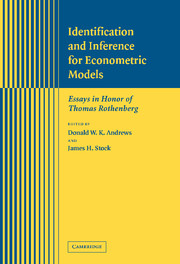Book contents
- Frontmatter
- Contents
- List of Contributors
- Preface
- Part I Identification and Efficient Estimation
- 1 Incredible Structural Inference
- 2 Structural Equation Models in Human Behavior Genetics
- 3 Unobserved Heterogeneity and Estimation of Average Partial Effects
- 4 On Specifying Graphical Models for Causation and the Identification Problem
- 5 Testing for Weak Instruments in Linear IV Regression
- 6 Asymptotic Distributions of Instrumental Variables Statistics with Many Instruments
- 7 Identifying a Source of Financial Volatility
- Part II Asymptotic Approximations
- Part III Inference Involving Potentially Nonstationary Time Series
- Part IV Nonparametric and Semiparametric Inference
4 - On Specifying Graphical Models for Causation and the Identification Problem
Published online by Cambridge University Press: 24 February 2010
- Frontmatter
- Contents
- List of Contributors
- Preface
- Part I Identification and Efficient Estimation
- 1 Incredible Structural Inference
- 2 Structural Equation Models in Human Behavior Genetics
- 3 Unobserved Heterogeneity and Estimation of Average Partial Effects
- 4 On Specifying Graphical Models for Causation and the Identification Problem
- 5 Testing for Weak Instruments in Linear IV Regression
- 6 Asymptotic Distributions of Instrumental Variables Statistics with Many Instruments
- 7 Identifying a Source of Financial Volatility
- Part II Asymptotic Approximations
- Part III Inference Involving Potentially Nonstationary Time Series
- Part IV Nonparametric and Semiparametric Inference
Summary
ABSTRACT
This paper (which is mainly expository) sets up graphical models for causation, having a bit less than the usual complement of hypothetical counterfactuals. Assuming the invariance of error distributions may be essential for causal inference, but the errors themselves need not be invariant. Graphs can be interpreted using conditional distributions, so that we can better address connections between the mathematical framework and causality in the world. The identification problem is posed in terms of conditionals. As will be seen, causal relationships cannot be inferred from a data set by running regressions unless there is substantial prior knowledge about the mechanisms that generated the data. The idea can be made more precise in several ways. There are few successful applications of graphical models, mainly because few causal pathways can be excluded on a priori grounds. The invariance conditions themselves remain to be assessed.
INTRODUCTION
In this paper, I review the logical basis for inferring causation from regression equations, proceeding by example. The starting point is a simple regression; next is a path model, and then simultaneous equations (for supply and demand). After that come nonlinear graphical models. The key to making a causal inference from nonexperimental data by regression is some kind of invariance, exogeneity being a subsidiary problem. Parameters need to be invariant to interventions: this well-known condition will be stated here with a little more precision than is customary. Invariance is also needed for (i) errors or (ii) error distributions, a topic that has attracted less attention. Invariance for distributions is a weaker assumption than invariance for errors.
- Type
- Chapter
- Information
- Identification and Inference for Econometric ModelsEssays in Honor of Thomas Rothenberg, pp. 56 - 79Publisher: Cambridge University PressPrint publication year: 2005
- 6
- Cited by

